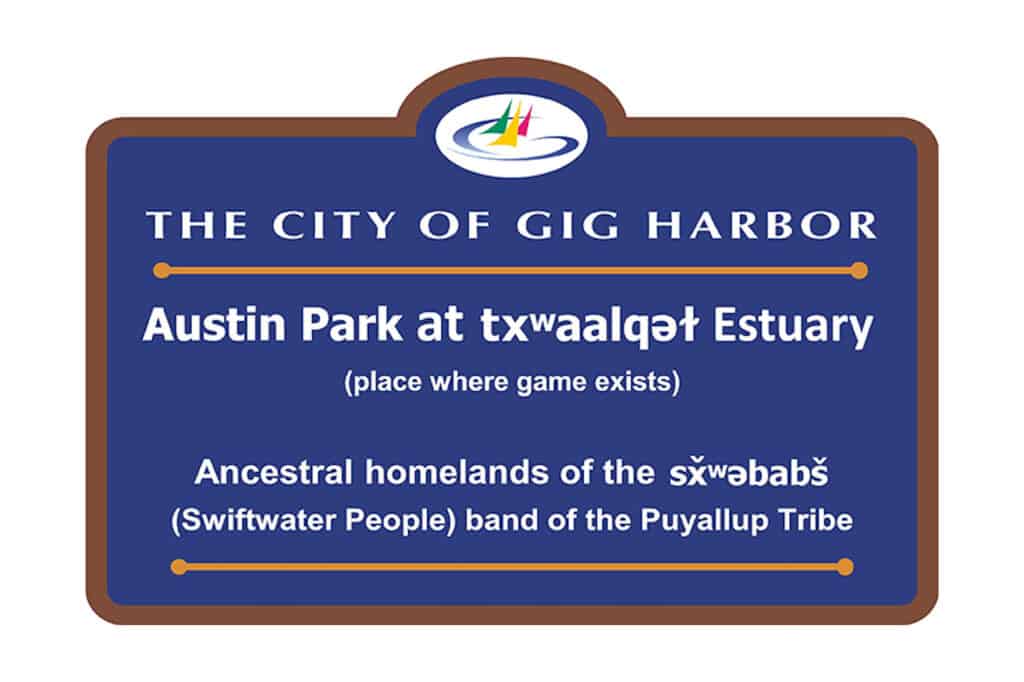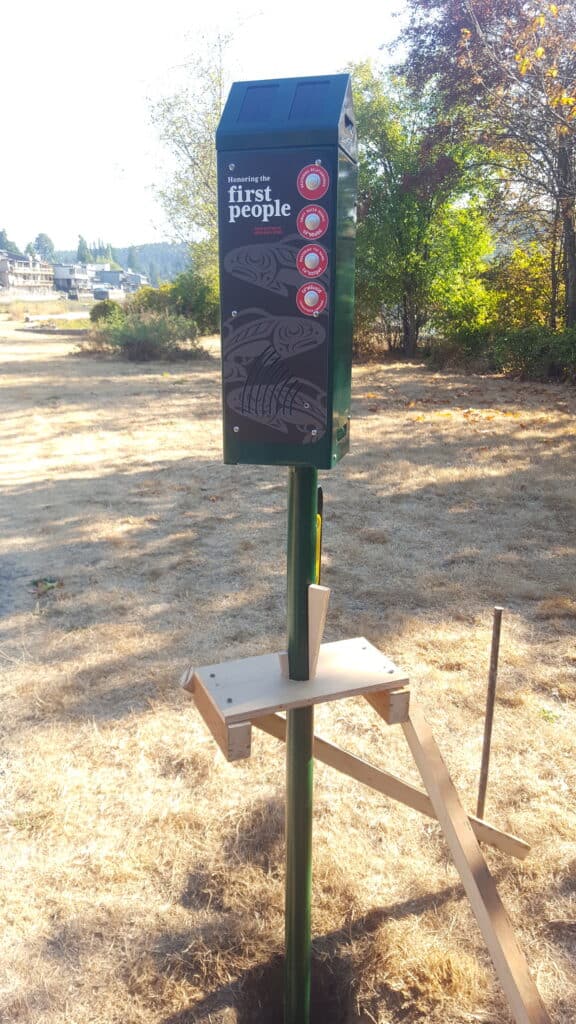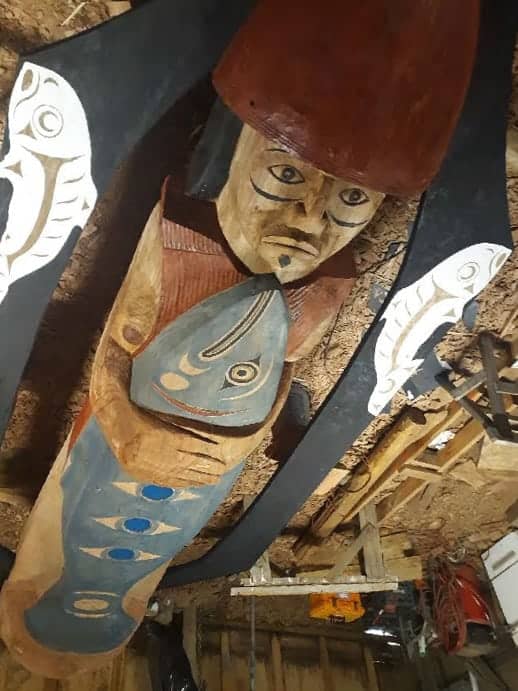Government
City, Puyallup Tribe acknowledge stronger relationship
It was Indigenous People’s Day, and for the first hour of its 3 1/2-hour meeting Monday, the Gig Harbor City Council heard about the ways in which the city and the Puyallup Tribe of Indians have worked together to establish a strong relationship over the past several years.
The meeting began with Mayor Kit Kuhn acknowledging that it was taking place “not only on the ancestral and traditional lands of the sxwəbabč band of the Puyallup Tribe of Indians, but also on the site of one of the largest and longest-standing historic villages of the people, the original inhabitants of Gig Harbor.” The acknowledgement will be read at the beginning of every Council meeting in October and November.
The mayor also read a proclamation declaring Oct. 11, 2021, as Indigenous People’s Day, in accordance with Resolution 1186, approved by the Council in September 2020. The resolution also establishes November as Native American Heritage Month and states that the Puyallup Tribal flag will be displayed in Council chambers during the months of October and November every year.
Several Tribal members attended the virtual meeting, including Tribal Council Member Anna Bean, Land Use Planner and Assistant Historic Preservation Officer Jennifer Keating, Historic Education Coordinator Charlotte Basch and Amber Hayward from the Tribe’s language department. Bean and Keating live in Gig Harbor and their children attend school here.
Bean spoke about the relationship-building that’s taken place and thanked all those who have been involved, especially Kuhn, for reaching out, government to government.
“I really value how the city of Gig Harbor has extended that reach in wanting to truly understand the Puyallup Tribe’s past and getting out all that information and becoming aware and knowledgeable in the city that you govern,” she said. “That’s incredibly beautiful and impactful on the folks that live here.”
She shared an experience her young daughter had in a Gig Harbor school recently when a teacher acknowledged that she knew the girl and that she is a Puyallup and that she had been watching the girl since she was little.
“My daughter isn’t usually friendly to people she doesn’t know, but she gave the teacher a big hug,” Bean said. “That’s just a sign of what this relationship-building is doing in insuring that our children are seen and heard and feel like they have an advocate. I appreciate the city of Gig Harbor contributing to that.”

Signage installed at Austin Park explaining the area’s Native history. Illustration courtesy of city of Gig Harbor
Kuhn discussed the renaming of Austin Park at txwaalqet Estuary and showed updated signage installed near Donkey Creek Park that tells the history of the sxwəbabč, and a solar-powered voice box in Austin Park that teaches how to pronounce the Lushootseed words. Hayward read the script for the four voice box buttons: Restoring Relationships, Swift Water People, Restoring the Name txwaalqet and txʷəlšucid — Lushootseed.

a voicebox with recorded messages installed at Austin Park. It tells a brief history of the estuary, with Tribal members speaking the Lushootseed words. Courtesy of city of Gig Harbor
Arts Commissioner Lynn Stevenson and Tribal member Basch talked about metal plaques that are being created for five concrete pylons in the estuary area. They tell a short version of the history of the Puyallup people in Gig Harbor.
Keating, a lifelong Gig Harbor resident, spoke about naming the new Swift Water Elementary School in Gig Harbor North and her own experiences in local schools.
City Council member Robyn Denson described the acquisition of 11.5 acres of forested land that was donated by a private citizen. The property is being acquired through the Conservation Futures process in a partnership between the city and the Tribe. The land is historically important to the Tribe and includes a salmon-bearing stream.
Tina Shumaker, president of the Kiwanis Foundation, gave an update on the creation of a large redwood sculpture of a welcoming figure, “Our Fisherman, Our Guardian,” that will be installed on the Austin Park shoreline this year. The sculpture will honor the Tribe as the original inhabitants of Gig Harbor. A small group of Gig Harbor citizens, led by retired teacher Gary Williamson, commissioned the sculpture, which was funded by the city’s Arts Commission, the Kiwanis Foundation and the Puyallup Tribe.

The Our Fisherman —Our Guardian sculpture by Guy Capoeman will be erected at Austin Park. Image courtesy of city of Gig Harbor
Guy Capoeman, president of the Quinault Nation and a noted sculptor, was commissioned to carve the figure. Capoeman described how he found a downed 100-year-old redwood tree, transported it to his studio and carved the figure of a fisherman clutching a huge salmon, flanked by two canoes. In conducting research for the project, Capoeman discovered that one of his ancestors had lived in Gig Harbor.
He also learned that Donkey Creek, which runs through the estuary, was a “real heavy salmon creek at one time and that big salmon still run there. So I wanted to symbolize the salmon’s struggle and our own salmon struggle that we’ve gone through over time as Indian people here in the Northwest — from the Boldt decision through global warming to all the things that are happening out in the ocean and all the things that are happening to all of our salmon. I wanted that to be the centerpiece, to show how important our relation is with that salmon. That’s why we hold onto it with our heart and our soul and our spirit.”
Public hearings on emergency ordinances
After a short break, Council members held public hearings on two emergency ordinances passed at the Sept. 27 meeting.
Resolution 1467 set a 6-month moratorium on processing new applications for short-term rentals — called Lodging Level 1 — such as bed-and-breakfasts. Principal Planner Carl de Simas reviewed the ordinance and explained that it is not a ban on short-term rentals. It’s a pause on granting new licenses to give city staff time to review and update policy. The city estimates that there are at least 44 such rentals and that only one is properly permitted. Three applications are in process and will continue to move forward.
About a dozen people spoke during the public hearing. Others sent written comments. Some did both, including former Gig Harbor city planner Peter Katich, supported the moratorium and the need for further study, and asked the city to come up with a plan that regulates short-term rentals that could change the character of a neighborhood.
Former City Council member Paul Kadzik agreed that there is a need to “clear up the gray areas” and that the Planning Commission should study the issue and make recommendations on changes to the city code.
Others were against the ordinance, including Chamber of Commerce Executive Director Miriam Battson, who submitted a letter of opposition. Others who opposed it questioned the need for the “emergency” designation. Others disapprove of short-term rentals in properties whose owners live elsewhere, but support rentals in homes where an owner resides.
After discussion, the Council voted unanimously to accept the findings of fact and send the resolution to the Planning Commission for study. The Commission must issue its recommendations by Feb. 28 so the Council can make its final decision by March 27 when the moratorium ends.
A public hearing was also held on Resolution 1466, which enacted interim zoning controls on transitional housing, permanent supportive housing, emergency shelters and emergency housing. Community Development Director Katrina Knutson explained that the regulations were adopted in response to ESSHB 1220, passed by the state Legislature in May. That bill requires that all cities planning under the Growth Management Act must amend their comprehensive plans and develop regulations regarding such housing.
Knutson outlined the schedule that will be followed over the next six months. In October and November, staff will conduct a thorough analysis of the requirements of HSSHB 1220 and forward it to the Planning Commission. In December and January, the Commission will hold work study sessions and public hearings to formulate their recommendations. On Feb. 28, the Commission will present its recommendations to the Council.
Transitional and emergency housing and shelters are hot buttons for those who spoke or sent letters. Many felt that the legislation is “a prime example of government telling us what we can and can’t do with our private property.” Carol Davis wrote that “the City Council needs to stand against this type of overreach by the state Legislature. They have no jurisdiction in local zoning laws. If this law is enforceable, the city will have to accept more edicts from the state as to how to govern our city.”
The Council voted 6-1 to move forward with the process, with Spencer Abersold voting against.
In other business, the Council accepted a donation of a small, undeveloped parcel of land from a private citizen, and had a first reading of an ordinance that changes the city’s “Bring Your Own Bag” regulations to comply with the state’s plastic bag ban. City Administrator Tony Paisecki reported that he plans to interview three finalists for the parks administrator position and hopes to have a selection within a few weeks.
To see a video of the meeting, visit cityofgigharbor.net and look for City Council meetings.
